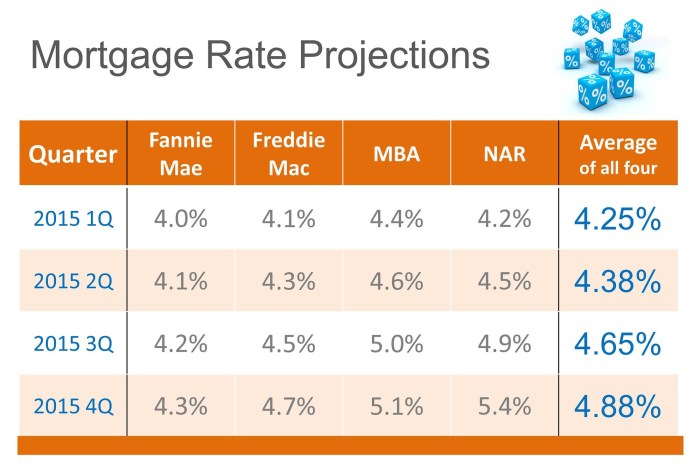Yo, peeps! So, let’s dive into the wild world of interest rates and mortgages. Buckle up ‘cause we’re about to break it down in a way that’s gonna make your head spin (in a good way, of course)!
Now, let’s get down to business and shed some light on the nitty-gritty details of how interest rates and mortgages play the ultimate game of cat and mouse.
Overview of Interest Rates and Mortgages
Interest rates and mortgage rates are closely related in the housing market. When interest rates rise or fall, mortgage rates tend to follow in the same direction. This relationship is important for potential homebuyers and current homeowners looking to refinance.
Interest rates play a significant role in determining mortgage rates. If interest rates increase, borrowers will likely see an increase in mortgage rates as well. Conversely, when interest rates decrease, mortgage rates are likely to drop too. This connection is due to the fact that lenders use interest rates as a benchmark when setting mortgage rates.
Factors Affecting Interest Rates in the Mortgage Market
- The Federal Reserve: The Federal Reserve’s monetary policy decisions can directly impact interest rates in the mortgage market. For example, if the Fed decides to raise the federal funds rate, mortgage rates may also increase.
- Economic Conditions: Factors such as inflation, unemployment rates, and overall economic growth can influence interest rates. A strong economy may lead to higher interest rates, while a weaker economy may result in lower rates.
- Housing Market Trends: Supply and demand in the housing market can affect interest rates. When there is high demand for housing, interest rates may rise. Conversely, when demand is low, interest rates may decrease.
- Credit Score: Borrowers with higher credit scores typically qualify for lower interest rates, while those with lower credit scores may face higher rates.
Types of Mortgages

When it comes to mortgages, there are different types available in the market to suit various needs and preferences. Two popular options include fixed-rate mortgages and adjustable-rate mortgages.
Fixed-Rate Mortgages
Fixed-rate mortgages have a set interest rate that remains constant throughout the life of the loan. This means that your monthly payments will stay the same, providing predictability and stability. It’s a great option for those who prefer consistency and want to avoid fluctuations in interest rates.
- Pros:
- Stable monthly payments
- Predictable long-term costs
- Protection against rising interest rates
- Cons:
- Initial interest rates may be slightly higher
- No benefit if market rates decrease
Adjustable-Rate Mortgages
On the other hand, adjustable-rate mortgages (ARMs) have interest rates that can change periodically based on market conditions. This means that your monthly payments can fluctuate, potentially resulting in lower initial rates but higher costs over time.
- Pros:
- Possible lower initial interest rates
- Chance to benefit from decreasing market rates
- Cons:
- Monthly payments can increase over time
- Uncertainty due to rate fluctuations
Impact of Interest Rates on Homebuyers
When interest rates rise, it affects homebuyers in several ways, primarily by impacting their purchasing power. Higher interest rates mean higher monthly mortgage payments, which can reduce the amount of house a buyer can afford.
Rising Interest Rates and Purchasing Power
- As interest rates increase, the cost of borrowing money to purchase a home goes up.
- This increase in borrowing costs can result in homebuyers qualifying for a smaller loan amount.
- Homebuyers may need to adjust their expectations and look for more affordable housing options.
Strategies for Navigating Fluctuating Interest Rates
- Locking in a mortgage rate when it’s low can provide protection against future rate increases.
- Consider adjustable-rate mortgages if you plan to sell or refinance before the rate adjusts.
- Improving credit scores and debt-to-income ratios can help secure better interest rates.
Influence of Interest Rate Changes on Decision-Making
- When rates are low, homebuyers may be more inclined to buy, leading to increased demand and potentially higher home prices.
- Rising rates may prompt some buyers to postpone purchasing a home until rates decrease again.
- Homebuyers need to weigh the pros and cons of buying now versus waiting for better interest rates.
Refinancing and Interest Rates
When interest rates fluctuate, it can have a significant impact on homeowners considering refinancing their mortgages. Here’s how changing interest rates influence the decision-making process:
Impact of Changing Interest Rates on Refinancing
- As interest rates decrease, homeowners may opt to refinance their mortgages to secure a lower rate, potentially reducing their monthly payments and overall interest costs over the life of the loan.
- Conversely, when interest rates rise, refinancing may not be as beneficial, as homeowners could end up with a higher rate than their current mortgage, resulting in increased monthly payments.
Considerations for Refinancing in a High-Interest Rate Environment
- Homeowners should carefully evaluate the closing costs associated with refinancing to ensure that the potential savings from a lower interest rate justify the expenses.
- It’s essential to consider the length of time you plan to stay in your home. If you anticipate moving in the near future, the cost of refinancing may outweigh the benefits of a lower interest rate.
Tips for Leveraging Low-Interest Rates for Refinancing
- Monitor interest rate trends and be prepared to act quickly when rates are favorable for refinancing.
- Consider refinancing to a shorter loan term to pay off your mortgage sooner and save on interest costs in the long run.
- Consult with a mortgage professional to explore all available options and determine the best refinancing strategy based on your financial goals.